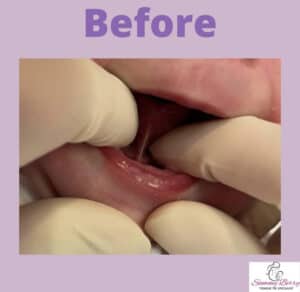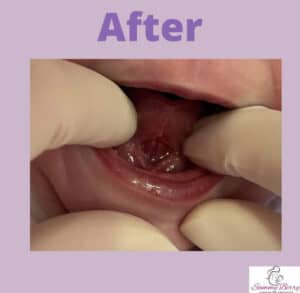Sammy Berry
Midwife, Tongue Tie Specialist https://tonguetiespecialistkent.co.uk/
@tonguetiespecialist
Summary
Ankyloglossia, or tongue ties, is an often underdiagnosed condition affecting infants and adults. The condition is caused by a tight or thick band of tissue connecting the bottom of the tongue to the floor of the mouth, which can restrict movement and cause a range of symptoms. In infants, tongue ties can interfere with feeding and other issues. Tongue tie release, a simple surgical procedure, can effectively treat the condition and improve the quality of life for those affected. However, proper diagnosis and treatment require awareness and understanding of the condition. This factsheet provides some information regarding tongue ties from Sammy, a tongue-tie specialist who experienced tongue-tie with her own three children.
What is ankyloglossia?
Ankyloglossia, also known as tongue-tie, is a developmental anomaly of the baby’s tongue which may result in limitation and restriction of the tongue’s function. This can affect both breast- and bottle-fed babies. The prevalence of tongue-tie ranges from 0.1% to 10.7% (ref). This is partly because of the lack of a single definition and the differences among investigators. Studies so far have found ankyloglossia seems more prevalent in males, with no racial link 1. However, this systematic review found it difficult to compare the studies it included due to a lack of accepted definitions at the time (2009).
How is ankyloglossia diagnosed?
During an assessment of the tongue function, the tongue’s mobility, digital suck, lateralisation, elevation and protrusion are all assessed, and the location of the anchored lingual frenulum is visualised. In order to correct the restriction of the tongue, thus improving feeding outcomes for mother and baby, release of the tongue-tie can be performed.
It is important to note that a tongue tie can only be diagnosed by a tongue-tie specialist. It is common for other healthcare professionals to tell parents their babies are or are not Tongue-tied. Sadly, whilst they have the best interests at heart to offer reassurances or answers, this is out of their scope of practice. There is no training for midwives, health visitors, GPs, lactation consultants or paediatricians.
You cannot see a tongue-tie – a physical functional assessment must occur, which they are not qualified to do.
If symptoms of Tongue-tie are present, I recommend seeking lactation consultant support to ensure this is not a positioning and attachment issue. If symptoms are not resolved, they may refer you to the NHS to see a tongue-tie specialist; alternatively, you can seek a private specialist.
Classifying the appearance of the tongue frenulum by lifting the tongue or visualising the frenulum is not an accurate way to diagnose a tongue-tie.
Just because a frenulum is visible does not mean a baby’s tongue function is restricted, and symptoms of a tongue-tie may also result from another cause, for example, birth trauma, low muscle tone, positioning and attachment. There are controversial opinions on whether all tongue ties need to be released. Many adults and older children have a tongue tie and are perhaps unaware. There are also many who are aware and have difficulties as a result. We will all learn and adjust to compensate for what we have, but this is not ideal. If tongue-tie symptoms are present and therefore causing difficulties, advice would be to seek support from a specialist for a plan going forward. If a frenum is present that does not impede function, it does not need to be released and would not be a tie. Getting accurate assessment and support is vital.
Frequent symptoms associated with ankyloglossia 2
- Difficulty attaching to the breast and sustaining latch
- Fussy with the bottle teat/spilling milk from the sides of the mouth
- Particularly long feeds or short/frequent feeding
- Unsettled behaviour during feeds
- Slow or poor weight gain
- ‘Clicking’ sound when feeding
- Sore/cracked/misshapen nipples
- Mastitis
- Low milk supply
- Reflux
- Weaning difficulties
You may have heard of different types of ankyloglossia…anterior? Posterior? Submucosal?
There is actually no universally agreed way of classifying a tongue-tie 3
An anterior frenulum is where the tip is attached close to, or at the tip of the tongue. These are often easy to spot, and the tongue can appear heart-shaped.
A posterior tie is often easy to miss. The frenulum is often hidden at the base of the tongue and can be found by lifting the tongue or sweeping a finger laterally underneath the back of the tongue. Here, you would feel a ridge/resistance. Whilst these are not so visible, they can also prevent babies from feeding effectively.
It’s important to note that the ‘different types’ are anatomical and do not relate to how badly the tongue-tie will affect feeding.
Essentially, a tongue-tie is a tongue-tie and is one continuous structure; therefore, the terminology anterior or posterior is irrelevant and can just become confusing or worrying for parents.
What is the ‘treatment’ for ankyloglossia?
If a tongue-tie diagnosis is made by the specialist and frenotomy (Tongue-tie release) is deemed clinically necessary, a specially shaped pair of scissors is used to release the frenulum. This is a relatively painless procedure as the frenulum has few nerve endings. Bodywork and oral exercises are often recommended pre and post-release for optimal results.
Tongue tie release is one piece of the puzzle; addressing bodywork, intraoral exercises, and continued feeding support is also essential.


References
Please use the latest/most notable references for this topic. Use AMA numerical referencing. Guide at end.
- Suter, V. G., & Bornstein, M. M. (2009). Ankyloglossia: facts and myths in diagnosis and treatment. Journal of Periodontology, 80(8), 1204–1219. https://doi.org/10.1902/jop.2009.090086
- Melong J, Bezuhly M, Hong P. The Effect of Tongue-Tie Release on Speech Articulation and Intelligibility. Ear, Nose & Throat Journal. 2021;0(0). doi:10.1177/01455613211064045
- Oakley. S., (2017) Tongue Tie in Babies: A Guide for Parents









